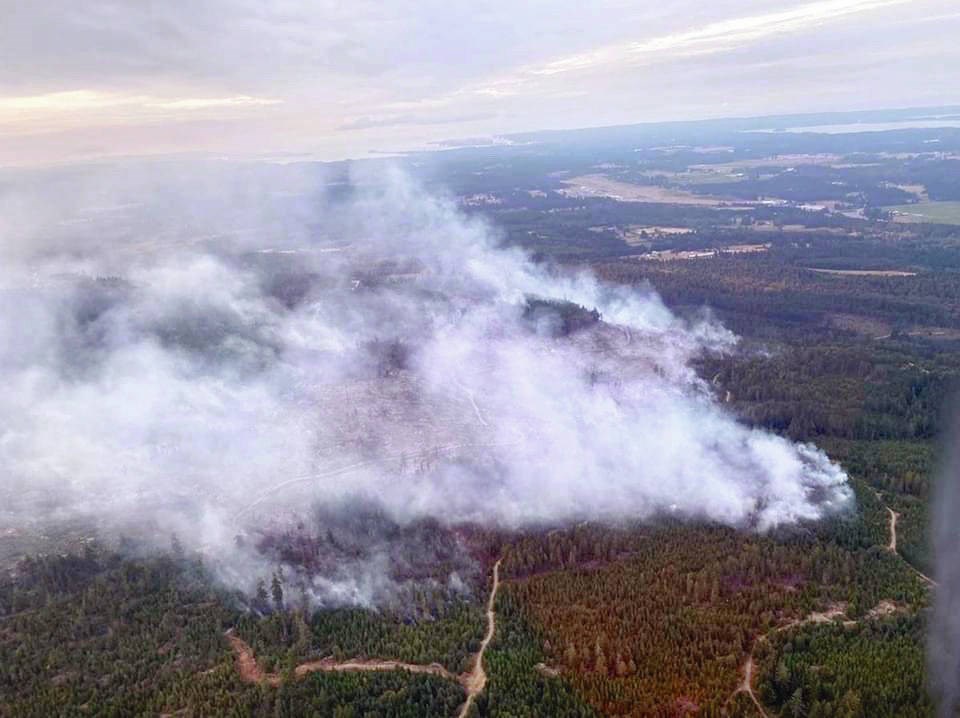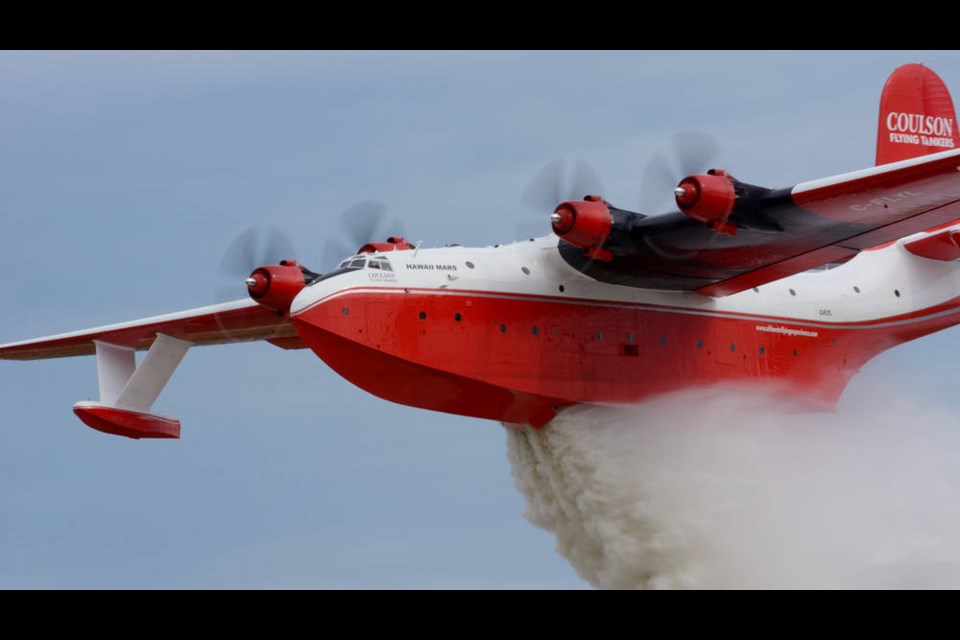The Martin Mars water bomber sits idle on the shores of Sproat Lake, raising questions about why the massive aircraft isnŌĆÖt being used to fight the flames ripping though the province ŌĆö including in its own backyard.
The short answer, according to the sa╣·╝╩┤½├Į Wildfire Service, is the Martin Mars ŌĆ£is a retired aircraft that hasnŌĆÖt been used in sa╣·╝╩┤½├Į since 2015,ŌĆØ said spokeswoman Jean Strong.
The service is contracting a fleet of smaller fixed-wing tankers and helicopters that can target fires quickly and efficiently, she said.
Wayne Coulson, chief executive of the Coulson Group of Companies and owner of the Martin Mars tanker, disagrees with the strategy. He flew over the Mount Hayes fire near Ladysmith this week on his way home from California, where his companyŌĆÖs aviation division is fighting fires on several fronts.
He said a few dumps from a tanker like the Martin Mars would have ŌĆ£a huge effect on that fire.ŌĆØ
The sa╣·╝╩┤½├Į Wildfire Service should be using ŌĆ£every tool in the toolboxŌĆØ during the wildfire season, he said, and that includes large tankers like the Martin Mars and CoulsonŌĆÖs converted Boeing 737s.
Coulson said the province has spurned his companyŌĆÖs contract offers for years, even after he explored converting the Martin Mars to turbo engines. As it stands, the former transport plane is grounded for the foreseeable future, its firefighting days done. The last time it attacked a fire in sa╣·╝╩┤½├Į was in 2015, when the province awarded Coulson a 30-day contract.
ŌĆ£They just donŌĆÖt want it,ŌĆØ he said. ŌĆ£[The wildfire service] have their own ideas on how to fight fires, and they are the only place in the world who think that way.ŌĆØ
The irony of the Port Alberni-based company not working within its own province isnŌĆÖt lost on Coulson. The company has been working outside of the country for years, contracting firefighting with the U.S., Australian and Chilean governments.
The Martin Mars Hawaii packs a walloping wet punch with a tank capacity of 27,000 litres. CoulsonŌĆÖs converted 737 tankers and C-130s drop more than 15,000 litres at a time.
But, says the wildfire service, those aircraft need big bodies of water with lots of room to land, fill and take off again ŌĆö and ground crews have to clear out when the plane makes its drop.
ŌĆ£The Martin Mars had a big dramatic drop, but modern aircraft allow crews to keep working,ŌĆØ Strong said.
There are about 110 bodies of water where a large tanker like the Martin Mars can make its long scooping runs, whereas smaller air tankers have more than 1,700, the provincial wildfire service said.
(Coulson discounts that, noting that Okanagan Lake, one of the largest bodies of waters in the province, is in the centre of this yearŌĆÖs fire activity.)

The AT-802F Fire Boss air tankers currently under contract with the sa╣·╝╩┤½├Į Wildfire Service can collect 3,000 litres of water in about 15 seconds and have a much shorter takeoff distance compared with the Martin Mars.
Strong said the service is using two groups of FireBoss air tankers ŌĆö a group of six based in Kamloops and a group of five in Penticton, where the most dangerous fires are ┬Łpersisting.
The wildfire service has 38 fixed-wing air tankers under contract, accompanied by eight ŌĆ£bird dogŌĆØ aircraft to guide them.
Strong said total skimming capacity among the fixed-wing fleet is about 42,000 litres.
But the workhorse in the sa╣·╝╩┤½├Į fire fight is the helicopter, able to cycle quickly between water pickup and drop sites.
The service currently has 168 helicopters on contract. Bucket technology has improved to the point where water can be scooped from ponds, streams and lakes less than a metre deep.
About 860,000 hectares of land have burned in sa╣·╝╩┤½├Į so far this season. By this time in 2017 ŌĆö a record year for fires ŌĆö it was 1,128,146 hectares.
The Coulson Group was assembling aircraft in northern California east of Sacramento to attack the massive Caldor fire that has forced thousands of people to evacuate and burned homes, churches, schools and businesses.
In places like California where more populated areas are threatened, Coulson said, there is a stronger sense of urgency to throw everything at a fire ŌĆö including tankers.
ŌĆ£Small helicopters with 300- or 400-gallon tanks donŌĆÖt have big impacts on big wildfires,ŌĆØ he said. ŌĆ£They may be good for spot fires, but on the big ones, youŌĆÖve got to kill them quickly.
ŌĆ£In places like the Los Angeles Basin with 18 million people in three counties, we can get a call out for a fire at 2:30 a.m. and by 4:30 a.m. weŌĆÖre done.ŌĆØ
History of the Martin Mars
The Martin Mars is a storied beast. Only seven were ever made by the Glenn L. Martin Company, all for the U.S. navy as ocean patrol and long-range transport during the Second World War. Most were used for naval cargo on the San Francisco-Honolulu route until 1956.
The last four, sold as scrap, were bought by a sa╣·╝╩┤½├Į forestry consortium and later converted to water bombers. The fleet as halved after one Mars crashed while fire fighting in Northwest Bay in 1961 ŌĆö with the loss of four crew; another was critically damaged in a storm.
The remaining two Martin Mars bombers were acquired by Coulson in 2007. The Philippine Mars was retired in 2012 and the Hawaii Mars, still operational, had its last fire season in sa╣·╝╩┤½├Į in 2015, when it secured a 30-day contract.
Coulson has since converted Boeing 737s and uses the Hercules C-130 in its tanker fleet.



